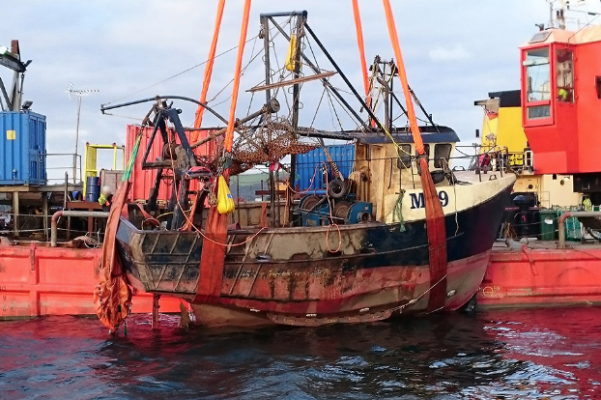Nearly one year since the sinking of the scallop dredger, JMT, an official investigation has identified a series of safety failings which led to two deaths.
7 July
The scallop dredger, JMT was fishing off Rame Head, near Plymouth on 9 July 2015 when routine contact was lost in the afternoon.
On board the 11.4 metre vessel was the 22-year-old skipper, Michael Hill and crew mate Shane Hooper, aged 33.
A search and rescue operation was initiated the following morning when the vessel did not return to port.
This was because the skipper’s father had informed Falmouth Coastguard that the vessel might stay out to sea overnight.
Officers continued to attempt to contact and locate the JMT throughout the night. A “Pan Pan” was also transmitted.
The body of Hooper, a father of three, was found by the crew of a passing yacht at 09.38 on 10 July.
He was floating in a life-ring, 3.8 nautical miles off Rame Head and was not wearing a lifejacket.
Hill, whose father owned the JMT, was never found.
Following an investigation, the Marine Accident Investigation Branch (MAIB) has concluded that the JMT “capsized suddenly and without warning and sank very quickly” at around 15.00 on 9 July.
As a result, the crew’s likelihood of survival was reduced.

JMT’s EPIRB located on the wheelhouse bulkhead. Credit MAIB
“Although the crewman clearly survived the capsize and was able to use one of the vessel’s life-rings to keep him afloat and to kick off his footwear, he was not wearing a lifejacket, the life raft did not surface and the EPIRB remained in its stowage in the wheelhouse,” stated the report.
“This was tragic; with a sea water temperature of 13.6°C in slight seas, the crewman could have been expected to survive for between 1 and 6 hours,” concluded the MAIB.
A post mortem examination revealed that Hooper had amphetamine in his system. The MAIB concluded he had taken the drug shortly before sailing or while out at sea.
“It is not known how the taking of amphetamines affected the crewman’s ability to
survive. However, as he had been in the water for over 18 hours when he was found,
it is probable that it did not influence the outcome,” said the MAIB.
Investigators also found the scallop dredger had been extensively modified, which seriously affected the vessel stability.
At the time of the sinking, JMT’s skipper, who had not completed stability training, was emptying the dredges.
This is believed to have triggered the capsize.
The MAIB also found that the scallop dredger had only 25% of the reserve of stability required for larger fishing vessels.
The JMT was not subject to stability criteria because it was less than 15 metres.
The vessel’s stability had also been adversely affected by structural modifications.
JMT had been inspected part-way through modifications by the industry body, Seafish in September 2013.
The Maritime and Coastguard Agency (MCA) had accepted the report “without challenge”, and the scallop dredger resumed fishing.
The MAIB stated “a further inspection was almost certainly warranted” to ensure the safety of the JMT.

The raising of the JMT. Credit: MAIB
It has made recommendations to the Maritime and Coastguard Agency, Seafish and
national fishing federations.
These aim to ensure that all small fishing vessels of under 15m are provided with stability information; that skippers of small fishing vessels are required to complete stability awareness training and that inspections of vessels against the Seafish Construction Standards are consistently robust and thorough.
“Currently, fishing vessels less than 15m length overall do not have to meet stability criteria. Consequently, a number of these vessels, particularly those that have been substantially modified and those engaged in scallop dredging, bulk fishing and trawling are at risk,” said the report.
“The Maritime and Coastguard Agency has action in hand to address this situation with regard to new vessels, but the need to ensure the safety of existing vessels through a straightforward and cost-effective means is equally compelling,” it concluded.
The MAIB is currently conducting its own review of the use of lifejackets in the UK fishing industry.
It noted that: “Effort has been expended by the MCA and the fishing industry to change the mind set of fishermen through educational campaigns and the provision of free constant wear lifejackets.”
“However, there appears to be no data available that could indicate whether such initiatives are effective and, perhaps more importantly, whether the wearing of personal flotation devices when working on deck should become a mandatory requirement,” it stated.
14 July, 2015
Police dive teams are set to undertake an underwater search of a sunken boat in the hope of finding a missing fisherman.
The scalloper fishing boat JMT was reported missing on Thursday evening, with a search being launched by the coastguard shortly after.
Related articles
Rescue crews scoured the coastline throughout Friday before discovering debris from the vessel, at which point they believed it to have sunk.
Two men were thought to have been aboard the boat, with one body being recovered off the coast of Plymouth on Friday.
The search has now been called off but police continue to investigate the possibility that the missing crew member may be within the wreckage.
Preparations are being made for a Force Dive Team to undertake recovery dives on Thursday.
Meanwhile, a post mortem of the recovered body will take place on Tuesday 14 July, with formal identification to be completed later in the week.



